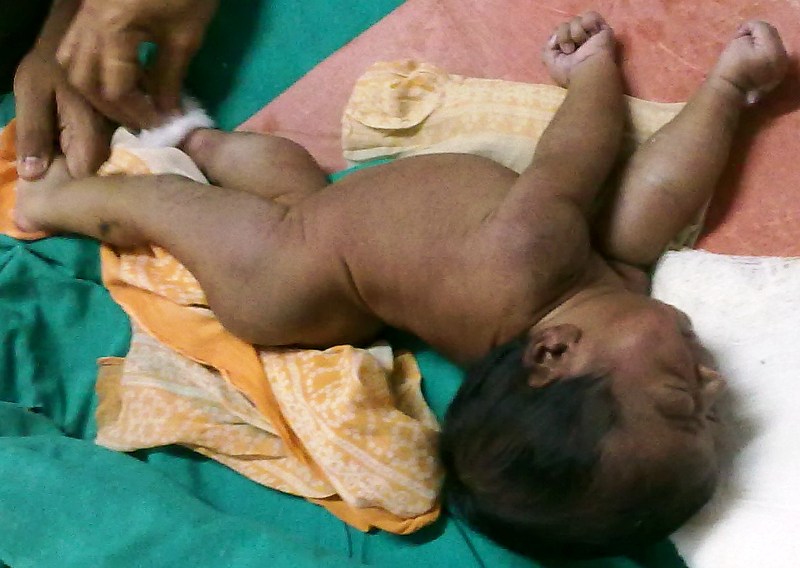Maternal and neonatal tetanus is not one of the commonly talked about causes of deaths of newborns and yet it is one of the most common life-threatening consequences of unhygienic deliveries and umbilical cord care practices.
As common as tetanus is, many are not aware that it is one of the killers of newborns. Lack of hygiene is the cause of infection, which results in high mortality. According to UNICEF, Maternal and Neonatal Tetanus (MNT) killed no fewer than 34,000 newborns in 2015 alone while a significant number of women also die due to maternal tetanus every year, globally.
Dr. Kizito Obi, the Head of the Non-Polio Supplementary Immunization Activity (NSIA) at the National Primary Healthcare Development Agency, (NPHCDA) explained that neonatal tetanus is a disease caused by the bacteria, Clostridium tetani, which can be contracted from contaminated soil. “If you have an open wound and the wound gets contaminated by the soil, you can contract tetanus.”
Obi, said, “Newborns contract tetanus majorly through delivery of children by unhygienic practice, poverty, little access to health care, and lack of information about safe delivery practices. Also, improper post-partum cord care, harmful cutting of the umbilical cord of the child using contaminated blade or rubbing the umbilical cord with contaminated towel or people using cow dung.”
While the old practice of using cow dung to heal the umbilical cord is weaning, unsanitary conditions and the lack of healthcare facilities still put children at risk of being delivered in unhygienic circumstances and exposing unvaccinated expectant mothers to the disease.
As a preventive measure, pregnant women are usually vaccinated during pregnancy. However, the worry for the newborn arises in its first 28 days after the vaccine effects begin to wear out. With 51.1 percent of Nigeria’s population based in rural areas, according to World Population Review, who have little or no access to proper healthcare and facilities and high maternal and neonatal mortalities, it is important for neonatal tetanus to take the front seat, as they are the most susceptible to contracting the disease.
As part of the process to eliminate the disease globally by 2020, and to raise more awareness about it, Nigeria is in the process of implementing the neonatal tetanus elimination agenda globally and will begin the Maternal and Neonatal Tetanus Elimination Campaign (MNTE) on October 18.

Some of the symptoms newborns exhibit due to tetanus infection is loss of appetite and general rigidity of the body.
Obi said, “All the muscles of the body will be in painful spasms which causes them to be rigid. Normally, you would see the child arching its back and the muscle of the knee extended and he would be in spasms. The bacteria that enters into the body from the wound, causes another characteristic of the symptom which is inability to open the mouth. This is commonly referred to as ‘lockjaw’ which makes the child unable to suck.
According to a study, ‘Perception of Tetanus Toxoid Immunization among women in a Niger Delta Community, Nigeria,’ “Nigeria amongst 27 other countries contributes to 90% of the worldwide burden of the infection. Out of the five million babies born annually in the country, 240,000 (4.8%) die within the first 4 weeks of life and tetanus accounts for up to 20% of these deaths with an incidence of 14.6 – 20/1000.”
Although Nigeria is one of the countries that are supposed to have initiated a high risk approach to ending neonatal tetanus, by 2020, Obi said, it is one of endemic countries, globally, where neonatal tetanus is still very prevalent. “Once the disease is contracted, the fatality rate can be as high as 100 per cent without hospital care and between 10 and 60 per cent with hospital care.”
He said, “There were about sixteen countries that are yet to eliminate neonatal tetanus at the end of 2017 and Nigeria is one of them.”
In his presentation on the overview of 2018 MNTE campaign, at a one-day media orientation forum, Obi told journalists that majority of mothers and newborns dying of tetanus live in Africa and Southern and East Asia.
The MNTE campaign will involve women of childbearing age – 15 to 49 years – in Nigeria’s east and south-south region where there are high rate local government areas with mortalities due to MNT.
Following a needs assessment, Obi said, “we know where to carry out the vaccination. There will be three rounds of campaign at the high risk areas while the moderate risk areas will have two rounds.”
Speaking on the demographics of the campaign so far and future plans, Obi said, “The south-east has done the MNTE and was certified free in September 2017. The south-west is almost free. A validation assessment has been done but we are now waiting for a validation assessment that will be done next year.
“For the south-south we are just starting the campaign. When we finish the campaign for three rounds and the two rounds, we will then do a free validation assessment before we can certify them free. The campaign will be done region by region after that we will go to the northern zone.”
The World Health Assembly first called for elimination of neonatal tetanus in 1989 and the goal expanded in 1999, to include the elimination of maternal tetanus. There were 57 countries yet to eliminate it back then. Presently, there are 59 including Timor Leste in 2002 and South Sudan in 2011.
The WHA said the goal is to eliminate MNT through focus on the TT-SIAs. “As of July 2018, 45 of these countries had achieved MNT elimination leaving 14 countries that still have not eliminated the disease.”
MNT elimination in a country is defined as neonatal tetanus rate of less than one case of neonatal tetanus per 1000 live births in every district of the country. UNICEF and WHO’s role in this global effort is:
To advocate with partners including the national governments to commit to the goal of MNT elimination and support it through allocation of needed resources
To fund raise for the initiative to meet the gaps in funding needs for the target countries
To support national ministries of health in preparing technically and financially sound plan
To procure and deliver the TT vaccines and injections supplies for the campaigns and ensure cold chain maintenance
To provide technical assistance for implementation of high quality campaigns
To monitor progress towards MNT elimination
To validate (usually through community based mortality surveys), if elimination level has been reached in a country following the country’s claim of elimination
To work with countries on strategies for maintaining MNT elimination including strengthening of routine immunization
Between 1999 and 2018, more than 150 million women have been immunized with two or more doses of TT vaccine. As of 2017, approximately 96% reduction of Neonatal Tetanus mortality has been achieved since 1988 globally.

 Join Daily Trust WhatsApp Community For Quick Access To News and Happenings Around You.
Join Daily Trust WhatsApp Community For Quick Access To News and Happenings Around You.


